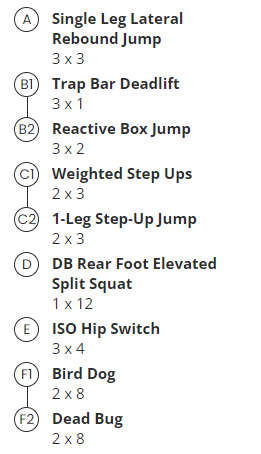500 Words a Week - In-Season Strength Training
A small case study looking at a congested fixture week.
The sessions below are from a programme for a player who is currently playing in League One.
I have discussed Mladen Jovanovic’s minimum viable programme and barbell loading strategy concepts before, but will touch on them again to show how they can help us adapt during times of uncertainty and congested fixtures. The programme below is during a 2-game week for an athlete playing in League One.
During times of congested fixtures, strength training can be the first thing that gets cut. However, in order to build robustness in our athletes this is not optimal, and so we must be extra refined in our prescription of exercise. During times of congested fixtures, we revert back to what our minimum viable programme (MVP) is. Using this MVP concept, we want to ensure that at a minimum our athlete is receiving some form of stimulus to all the decided upon important physical qualities.
This programme was performed in-between the first and second game, on the MD+2/-2 session.
Looking at the session and taking in the concept of MVP, we have ensured our athlete has:
Performed a variety of jumps
Lifted something heavy-ish at slow speeds (RPE 6-7/10 due to MD-2)
Lifted something moderately heavy with speed
Lifted something for several reps
Isolated the posterior chain
We have ensured volume is kept incredibly low with some form moderate intensity in. We are dipping our toes into the water, rather than diving in.
Is this programme all encompassing? No. Is this programme enough to drive further adaptation? Potentially. Enough to maintain the identified important physical qualities? Most likely. However, most importantly the programme provides enough of a stimulus that when we return to a normal game week structure we aren’t worried about significant DOMS occurring that may have occurred after missing a week of strength training.
We then use the concept of barbell loading strategy when we return to our usual week. This highlights that we must protect from the downside by ensuring we are doing enough to maintain physical qualities. Then when the time is right we can invest in the upside by placing a higher level of loading onto certain physical qualities to improve them.
During our congested fixture week, we are looking to protect from the downside of congested fixtures in terms of being smart with our programming to not already add much fatigue onto an already fatigued athlete while still ensuring each important physical quality is receiving a stimulus.
When we return to a normal week, we can go back to being slightly more aggressive with our programming structure. Such as below, which was the programme performed by the athlete once returning to a 1-game week after the congested fixture week. We can add more volume and place more emphasis onto certain physical qualities we are trying to improve.
Session 1 was performed on the MD-4 session, session 2 was performed on the MD-2 session.
Not included are the upper body strength work sessions performed by this athlete.
An important point to finish upon is about understanding the players you work with. One of the main drivers behind the session at the top is that this player has a large training history and is accustomed to the exercises above. We know how he responds to them, so we can implement them to a lesser degree during congested fixtures with no interference to his sport performance.

